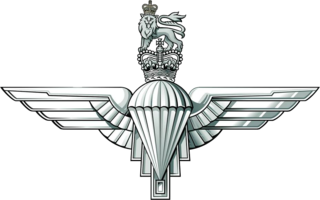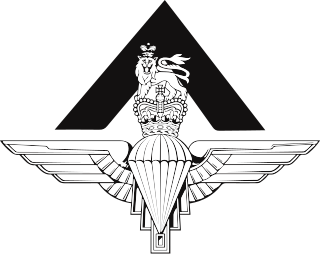
A paratrooper is a military parachutist—someone trained to parachute into a military operation, and usually functioning as part of airborne forces. Military parachutists (troops) and parachutes were first used on a large scale during World War II for troop distribution and transportation. Paratroopers are often used in surprise attacks, to seize strategic objectives such as airfields or bridges.

The Parachute Regiment, colloquially known as the Paras, is the airborne and infantry regiment of the British Army. The first battalion is part of the Special Forces Support Group under the operational command of the Director Special Forces. The other battalions are the parachute infantry component of the British Army's rapid response formation, 16 Air Assault Brigade. The Paras, along with the Guards, are the only line infantry regiment of the British Army that has not been amalgamated with another unit since the end of the Second World War.

In military organizations, a pathfinder is a specialized soldier inserted or dropped into place in order to set up and operate drop zones, pickup zones, and helicopter landing sites for airborne operations, air resupply operations, or other air operations in support of the ground unit commander. Pathfinders first appeared in World War II, and continue to serve an important role in today's modern armed forces, providing commanders with the option of flexibly employing air assets. There was a group of pilots who were also designated pathfinders. They flew C-47 (DC-3) aircraft and were the lead planes followed by paratroop transports, used for dropping paratroopers into designate drop zones such as on D day, the Normandy Invasion.

44 Parachute Regiment is the South African Army's chief airborne infantry unit. It was created in 2000 by redesignating 44 Parachute Brigade, and is based at the Tempe military base near Bloemfontein.

The Parachute Regiment is an airborne and special forces regiment of the Indian Army. It was raised in 1945 as part of the British Indian Army but was disbanded after World War II and was re-raised in 1952 as part of the Indian Army. Currently it consists of fifteen Special Forces, two Territorial Army and one Rashtriya Rifles battalions.

16 Air Assault Brigade Combat Team, known simply as 16 Air Assault Brigade from 1999 – 2021, is a formation of the British Army predominantly based in Colchester, Essex. It makes up the Air Assault Task Force, a battlegroup held at high readiness, and is the only brigade in the British Army focused on operating via parachute, helicopter and air-landing.

The Pathfinder Platoon is a pathfinder unit of the British Army, and an integral part of 16 Air Assault Brigade. The Pathfinder Platoon acts as the brigade's advance force and reconnaissance force. Its role includes locating and marking drop zones and helicopter landing zones for air landing operations. Once the main force has landed, the platoon provides tactical intelligence and offensive action roles for the brigade.

The 505th Parachute Infantry Regiment, originally the 505th Infantry Regiment, is an airborne infantry regiment of the United States Army, one of four infantry regiments of the 82nd Airborne Division of the United States Army, with a long and distinguished history.

The 504th Infantry Regiment, originally the 504th Parachute Infantry Regiment, is an airborne forces regiment of the United States Army, part of the 82nd Airborne Division, with a long and distinguished history. The regiment was first formed in mid-1942 during World War II as part of the 82nd Airborne Division and saw service in Sicily, Italy, Anzio, the Netherlands, Belgium and Germany.

The 4th Parachute Brigade was an airborne, specifically a parachute infantry, brigade formation of the British Army during the Second World War. Formed in late 1942 in the Mediterranean and Middle East, the brigade was composed of three parachute infantry units, the 10th, 11th and 156th Parachute Battalions.
El Gamil is a fortress with an airfield in Port Said Governorate, Egypt. It was the landing site of British paratroopers in the 1956 Suez Crisis.

General Sir Gerald William Lathbury, was a senior British Army officer who fought during the Second World War, serving with distinction with the British Army's airborne forces, commanding the 1st Parachute Brigade in Sicily, Italy and Holland. He later became Governor of Gibraltar from 1965 to 1969.

The 4th Battalion, Parachute Regiment, is an Army Reserve unit of the British Army. Now recruiting across the United Kingdom originally the Battalion covered the North of England, with its headquarters located in Pudsey, West Yorkshire. Following the Options for Change review in 1993, 4 PARA amalgamated with the 15th (Scottish) Battalion of the Parachute Regiment, which was downsized and became 15 (Scottish) Company of 4 PARA. As part of further changes in 1999, the Battalion also merged with the 10th (Volunteer) Battalion which then became 10 (London) Company.

The Second Battalion, Parachute Regiment, is a formation of the Parachute Regiment, part of the British Army, and subordinate unit within 16th Air Assault Brigade.

The 3rd Battalion, Parachute Regiment, is a battalion sized formation of the British Army's Parachute Regiment and is a subordinate unit within 16 Air Assault Brigade.

Colonel John Llewellyn Waddy, was a British Army officer who served during the Second World War, in Palestine and during the Malayan Emergency, before becoming Colonel of the SAS.

The 11th Parachute Battalion was an airborne infantry battalion of the Parachute Regiment, raised by the British Army in World War II.

The 1st Airlanding Light Regiment was an airborne forces unit of the British Army's Royal Artillery during the Second World War.

The 16th Parachute Brigade was an airborne infantry brigade of the British Army.
David Theodore Dobie, was a British Army officer who fought during the Second World War. He had a leading role during the Battle of Arnhem and was the architect of Operation Pegasus I, successfully evacuating a large group of men trapped in German-occupied territory who had been in hiding since the Battle of Arnhem.

















